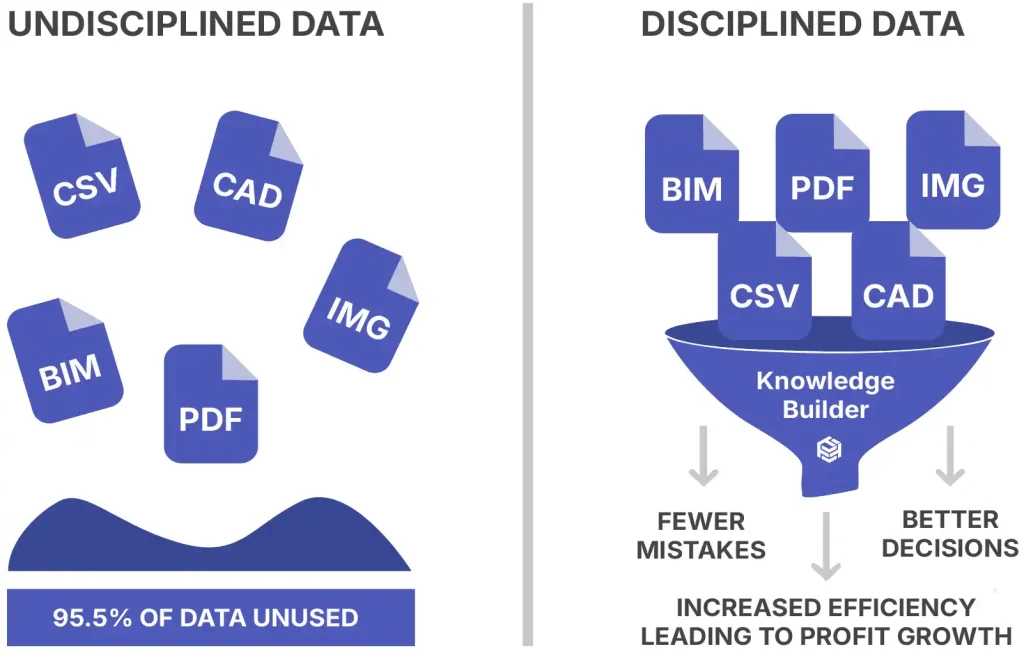In the architecture, engineering, and construction (AEC) industry, data discipline is proving to be a major competitive advantage. Recent research by Autodesk and Deloitte found that companies classified as “data leaders” enjoy roughly 50% higher profit growth on average each year compared to their peers who lag in data use. In other words, firms that treat their project data as a strategic asset are seeing significantly faster profit increases. Why? Because disciplined data practices cut waste, inform better decisions, and help teams avoid costly mistakes.
Conversely, the industry today struggles with untapped information – an estimated 95.5% of all data collected on construction projects goes unused. That’s a huge missed opportunity. It’s becoming clear that profit grows when data is disciplined and put to work, not just collected and forgotten.
Being Data-Driven: Turning Project Info into Knowledge
So what does it mean to be “data-driven” in an AEC firm? It’s more than just using software or collecting lots of project files. Being data-driven means turning everyday project information into institutional knowledge that improves decisions on the next job. Every project generates a wealth of insights – lessons learned, innovative details, solutions to problems – but too often these remain trapped in PDFs, CAD drawings, emails or someone’s notebook. A truly data-driven firm captures those insights and makes them searchable and accessible for future use. Instead of reinventing the wheel each time, teams can leverage past know-how to inform new designs and avoid repeating errors.
“Since most of the world’s data is unstructured, an ability to analyze and act on it presents a big opportunity.” – Mikey Shulman, Head of Machine Learning at Kensho.
In short, there’s immense value locked up in project data. The goal is to transform that raw information into usable knowledge – a kind of organisational memory that guides smarter decision-making on every project.
Removing Friction: Tackle Silos and Inefficient Handoffs
If being data-driven is the goal, several common hurdles need to be removed. One major source of friction is the classic silo – when information is trapped in one department, system, or person’s laptop and not shared across the firm. Similarly, inconsistent handoffs between project phases (like from design to construction, or construction to operations) mean valuable context can get lost. And much knowledge in AEC is localised – residing with individual veterans or in regional offices – rather than centralised for all to learn from.
All these issues slow down delivery and chip away at profits. In fact, studies show construction professionals waste enormous time just trying to find or reconcile data; managers spend 11.5 hours per week (a full working day!) on data research and analysis on average. That’s time not spent building or problem-solving. Reducing this friction requires making information flow more seamlessly. It means breaking down silos so everyone from the design team to the site team works from the same information, and ensuring each handoff of data is smooth and complete.
What ‘Good’ Data Practice Looks Like in AEC
So, what does “good” truly look like when it comes to data in an AEC firm? It helps to envision the end state. In a data-driven practice, all project data lives in one central, easily searchable system rather than scattered about.
The organisation establishes a shared taxonomy and standard templates so that everyone classifies and captures information consistently (no more one-off folder structures or personal naming conventions). When data is standardised, it becomes much more usable – in fact 41% of contractors admit that non-standardised data leads to inconsistent, inaccurate or unusable information, underscoring the importance of having common data standards. Here’s what “good” tends to include:
- A Single Source of Truth: A central repository (or connected platform) where all project documents, plans, reports, and BIM data are stored. This breaks down silos and ensures everyone accesses the latest information.
- Shared Taxonomy & Templates: Firm-wide standards for naming, tagging, and formatting data. For example, using standard document templates or drawing naming rules so that a “Level 1 Floor Plan” is labeled the same way on every project. This consistency makes it possible to search and aggregate data later.
- Instant Searchability: Powerful search tools (increasingly with AI assistance) so that any team member – whether an architect looking for past design details or a site manager recalling a solution to a problem – can query the knowledge base and find answers in seconds.
When these pieces are in place, data becomes a strategic asset.
Centralising Know-How with Tektome KnowledgeBuilder
Achieving the ideal state above might sound daunting, but modern tools are emerging to help AEC teams get there. Our Tektome’s KnowledgeBuilder is one such solution designed specifically to centralise AEC know-how, structure past data, and make it easily searchable – and then some.

It tackles the industry’s knowledge gap by using AI to turn unstructured project files (drawings, photos, reports, mark-ups, etc.) into a structured, searchable knowledge base. In practical terms, what used to be buried in folders on a server becomes instantly findable. KnowledgeBuilder allows even non-IT staff to define what information to extract from documents using simple natural language instructions. For example, you can upload a batch of construction drawings and tell the system “Extract the drawing type and issue date from these,” and it will automatically pull out those fields and index them. Crucially, all this extracted data ends up in one central hub (the KnowledgeBuilder repository) that your whole team can query with a Google-like search interface. By connecting past decisions and lessons to current challenges, teams make smarter design choices and repeat mistakes far less often.
Tektome KnowledgeBuilder also removes the friction we discussed earlier. It breaks down silos by pooling knowledge from all projects and departments. It enforces consistency by structuring data under common attributes that you define (so whether a detail is in a PDF or a photo, it’s tagged in a standard way). And it certainly cuts search time – instead of manually digging through old files, an engineer can just ask the system and get answers in seconds.
Start Small and Scale Up for Long-Term Gains
For firms looking to improve their data practices and boost profitability, the key is to start small and then scale up. You don’t need to overhaul everything at once. A practical approach is to pilot one workflow or area with a tool like Tektome KnowledgeBuilder, prove out the value, and then expand from there.
For instance, you might begin by structuring and centralising one type of data (say, past design drawings or all RFIs) and getting your team comfortable with searching that knowledge base. As they see quick wins – finding answers faster, avoiding a rework incident, delighting a client with lessons learned – it builds momentum. Over time, you can bring more and more data into the system (meeting minutes, site photos, standards, etc.) and standardise additional processes.
The long-term goal is a fully integrated, insight-rich operation, but it’s achieved through incremental steps. See how structured knowledge can change the way you work – start with booking a demo here.

